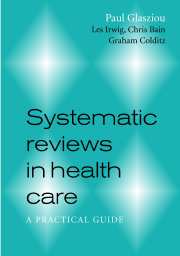7 - Frequency and rate
Published online by Cambridge University Press: 01 September 2009
Summary
The question
Questions of frequency (or prevalence) arise commonly in health care. For example:
What is the frequency of hearing problems in infants?
What is the prevalence of Alzheimer's disease in the over-70s?
What is the frequency of BrCa1 gene for breast cancer in women?
If the proportion changes over time, then a time period is incorporated into the definition to give a rate (or incidence). Thus, a possible question may be:
What is the rate of incidence of influenza in different seasons and years?
Traditionally, for diseases, prevalence is distinguished from incidence and the following quantities have been defined (Rothman and Greenland, 1998):
prevalence – the proportion of people who have the condition at a specific point in time (frequency of current cases);
incidence – the instantaneous rate of development of new cases (also known as the incidence rate or simply the rate); and
incidence proportion – the proportion of people who develop the condition within a fixed time period (also called cumulative incidence, with a specific example being the lifetime risk).
Incidence and prevalence are linked by the duration of illness, so that in a steady-state population:
Prevalence= incidence × duration
In this book, the terms ‘frequency’ and ‘rate’ are preferred to ‘prevalence’ and ‘incidence’ because not all questions refer to diseases, but may refer to risk factors such as diet, or false-positive rates (for diagnostic questions), and so on. The definition and calculation of frequencies and rates involve a number of subtleties, which are described by Rothman and Greenland (1998).
The apparent frequency may be greatly influenced by the case definition.
- Type
- Chapter
- Information
- Systematic Reviews in Health CareA Practical Guide, pp. 67 - 73Publisher: Cambridge University PressPrint publication year: 2001
- 6
- Cited by



